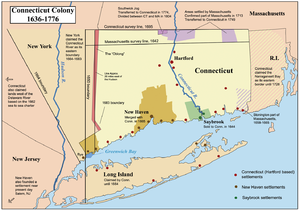
The territory of the United States state of Connecticut was first settled by Europeans in the 1620s, when Dutch traders established trading posts on the Connecticut River. English settlers, mainly Puritans fleeing repression in England, began to arrive in the 1630s, and a number of separate colonies were established. The first was the Saybrook Colony in 1635, based at the mouth of the Connecticut; it was followed by the Connecticut Colony (first settlement 1633, government from 1639) and the New Haven Colony (settled 1638, government from 1639). The Saybrook Colony merged with the Connecticut Colony in 1644, and the New Haven Colony was merged into Connecticut between 1662 and 1665 after Connecticut received a royal charter.
The Connecticut Colony was one of two colonies (the other was the neighboring Colony of Rhode Island and Providence Plantations) that retained its governor during the American Revolution. The last colonial governor, Jonathan Trumbull, became the state of Connecticut's first governor in 1776.